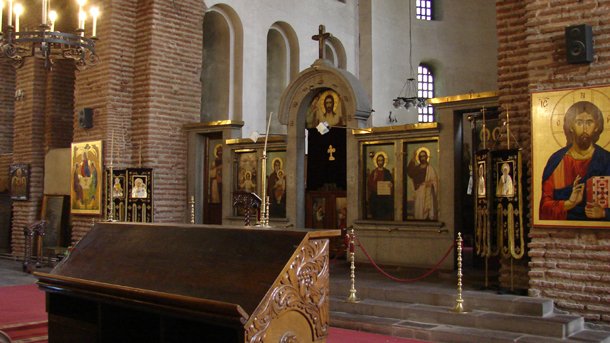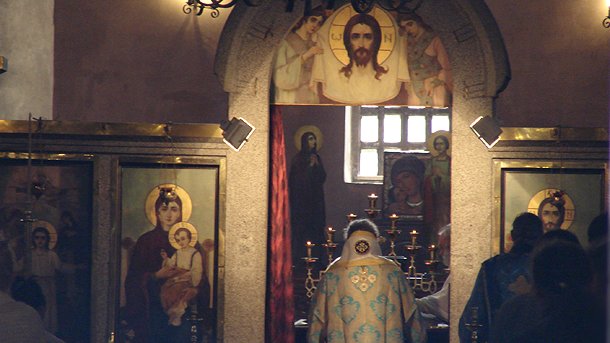The city of Sofia - ancient and modern, orderly and chaotic, eternal and constantly changing ... There are the different faces of the Bulgarian capital that many foreign guests rediscover every day. Tourists are most often interested in how and when the city was founded and how it has changed its appearance over the different historical periods. Answers to these questions can be found behind the walls of a landmark in central Sofia - the Hagia Sophia Church (or Saint Sophia). The moments of its historical development, just like the pieces of an ancient mosaic, arrange the complex puzzle of events that put its mark on the past of this city.

The walls of this church guard the legacy of the ancient town of Serdica. Today's basilica was built in the late 5th and early 6th century AD over the ruins of two earlier cemetery churches. It became the guardian of the eastern necropolis of Serdica. During various excavations, archeologists have unearthed a number of tombs, murals, and exquisite floor mosaics that are now being restored and conserved to be available for future tourists in a unique underground museum.
During the Middle Ages, in the early 9th century, the city, now under the name of Sredets was included in the territory of the Bulgarian state. After the adoption of Christianity by Bulgarians again in the 9th century, the temple continued to play an important role in the lives of local people. A testimony to its significance is the fact that in the mid-14th century, the town was renamed Sofia. After the Ottoman invasion, the church was turned into a mosque. Two large earthquakes, however, destroyed the minaret and the altar apse. After the liberation from the Ottoman rule in 1878, the building served as a gas storage facility for the urban lighting. Later, a watchtower of the metropolitan firefighters was installed on the roof. Archaeological research, however, reveals its high historical and artistic value. The church was later rebuilt and in 1930 it was consecrated and resumed its spiritual life. In the 1950’s, it was declared a monument of culture.

Although the church is dedicated to the wisdom of God, there are numerous interesting legends related related to its name that often do not match historical data. For example, Italian explorer Giovanni Benaglia who visited the city in 1682 wrote that the church was built by the daughter of Roman Emperor Constantine the Great and bears her name Sophia. Austro-Hungarian archaeologist and geographer Felix Kanitz in his travelogues also described the local story that the city was dedicated to a Byzantine princess named Sophia.
Wreathed in legend, Saint Sophia Churhc is not only one of the most important early Christian basilicas in Southeast Europe, but also an integral part of the life of Sofia residents. Not surprisingly, it is a favorite place for baptisms and one of the most beautiful wedding venues. Today, its doors are wide open for many laymen who come to here for the Sunday liturgy. Such as 27-year-old Adelina Simeonova from Sofia - one of many young Christians who come to the liturgy to take the sacrament of the Eucharist. For her, Saint Sophia Church is more than a place of worship:
"The reason I come to this church is that here, in this place, the faith in God changed me as if I started to live a new life. It gave me joy that I had never experienced before, and a sense of completeness and meaning. Attending the liturgy and taking the Holy Communion became an integral part of my life. Here I feel the spirit of the time, and communicating with many Christians aslo helps me because they became part of my family. This church is like my home, like a refuge. This is my meeting place with God”, young Adelina Simeonova from Sofia says.
A guardian of the city's history and an Orthodox church with a remarkable cultural and religious significance, Saint Sophia Church in central Sofia contiunes to be the beating heart of Bulgaria’s beautiful and ancient capital city.
Translated by Rossitsa Petcova
Photos: Maria Peeva
After nearly 35 years, the Bulgarian Orthodox Church Community in London has its own church in the central part of the British capital, in close proximity to the Bulgarian Embassy. There, in the prestigious Kensington district, next to Hyde Park and..
Meatfare Sunday in 2025 will be remembered as a major celebration for the Bulgarian Orthodox Church and the entire Bulgarian community in the United Kingdom. The "St. John of Rila" Orthodox Church, built with funds from the Bulgarian state and with..
All Souls' Day (Zadushnitsa in Bulgarian) is an important day for many Christians. On this day, we remember deceased relatives and loved ones. The first of the three All Souls' Days of the year, also known as the Great or All Souls' Day, falls on the..
After nearly 35 years, the Bulgarian Orthodox Church Community in London has its own church in the central part of the British capital, in close proximity..

+359 2 9336 661
